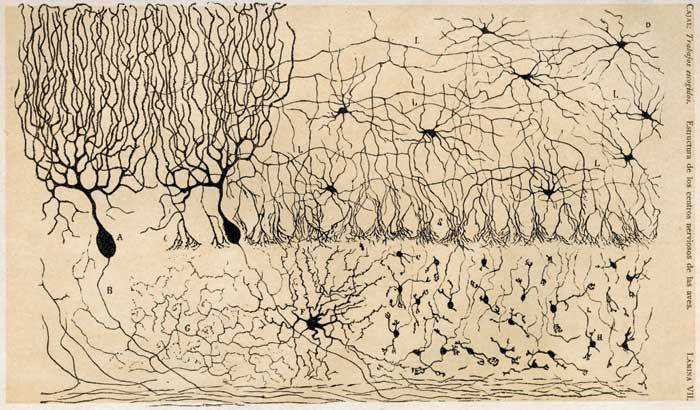Neuroscience is one of the most intriguing topics of study since,
as is commonly described, it comprises the mind attempting to understand
itself. Since art is conceived and created from the mind itself, it stands to
reason that the two fields would complement and enhance each other with such
harmony.
 |
| Drawing of cerebellum cells by Ramon y Cajal |
Neuroscientist Santiago Ramon y Cajal epitomizes the union
of these two worlds. His studies exploring neuroanatomy contributed
significantly to our understanding of the structure of the brain at a
microscopic level, earning him the Nobel Prize (Vesna). However, art also played
a large role in the work he was able to produce. His description of neurons as
the “butterflies of the mind,” and view of himself as an entomologist (Vesna)
illustrates the way he perceives himself as a scientist creating art, or
equally, an artist studying science. Indeed, his images of neurons achieve not
only scientific clarity, but also serve as artistic creations that expand our
ability to visualize and perceive the mind.
 |
| fMRI image of brain in action |
The advancements and technology of today’s modern world allow
this interface between neuroscientist and artist to attain even greater reach
and potential. For instance, inventor Christopher deCharms utilizes fMRI scans
to visualize brain activity in real time (deCharms), enabling us to visualize the
abstract concept of thought and thereby allowing for new insights into what it
means to think. Professor Michael Cohen pursues a similar purpose with a twist,
utilizing special inverting goggles to explore the effects of distorted perception
(Cohen).
Indeed, the connections between neuroscience, the study of
the mind, and art, the product of the mind, tie the two fields and their
success together. As D.T. Max observes, “writers and musicians lead the way to
new theories with inspiration, while scientists mop up with hard data” (Max 711).
The creativity and lack of boundaries defining art allow for full exploration of
the mind’s elements and capabilities. And in a similar way, understanding the
way the brain works enables us to apply it and express its holdings to their
full potential. Writer John Lehrer captures the mutual duality of this
relationship, expressing “science needs art to frame the mystery, but art needs
science so that not everything is a mystery” (Frazzetto and Anker 820).
 |
| "Brainbow" image of neurons, illustrating the potential of neuroscience combined with art |
References
Cohen, Mark S. “Neuroscience.” YouTube, uploaded by Victoria Vesna, 12 May 2012, https://www.youtube.com/watch?v=eDq8uTROeXU.
deCharms, Christopher. “A look inside the brain in real time.” TED, Feb 2008, https://www.ted.com/talks/christopher_decharms_scans_the_brain_in_real_time?language=en.
Frazzetto, Giovanni and Anker, Suzanne. “Neuroculture.” Nat Rev Neuroscience, vol. 10, no. 11, 2009, pp. 815-821.
Max, D.T. “Swann’s Hypothesis.” The New York Times, 4 Nov 2007, pp. 711.
Moore, Pamela. “TED deCharms.” Newton Street, https://newtonstreet.org/ted-christopher-decharms/. Accessed 20 May 2018.
Ramon y Cajal, Santiago. “Trabajos Escogidos.” Estructura de los centros nerviosos de las aves. 1905, Madrid. Harvard Medical School, https://hms.harvard.edu/news/butterflies-soul. Accessed 20 May 2018.
Vesna, Victoria. “Consciousness/Memory.” YouTube, uploaded by uconlineprogram, 17 May 2012, https://www.youtube.com/watch?v=TzXjNbKDkYI.
Weissman, Tamily. “Brainbow.” Cell, https://www.cell.com/pictureshow/brainbow. Accessed 20 May 2018.
I agree with you regarding how science needs art to define and introduce a new topic to the general audience. When we are exploring the unknown, visuals aid science in connecting the dots. We see art's effect as you mentioned through different scans using the MRI. Only through slices of the brain are we able to distinguish problems and the workings of the brain.
ReplyDelete